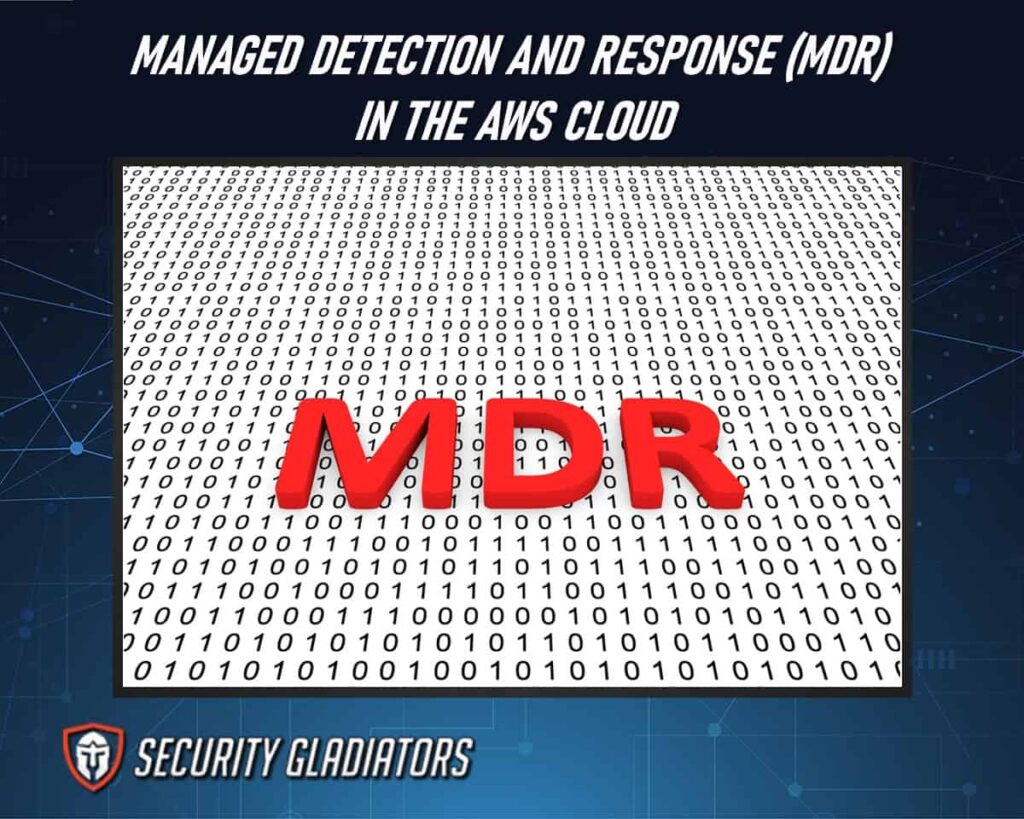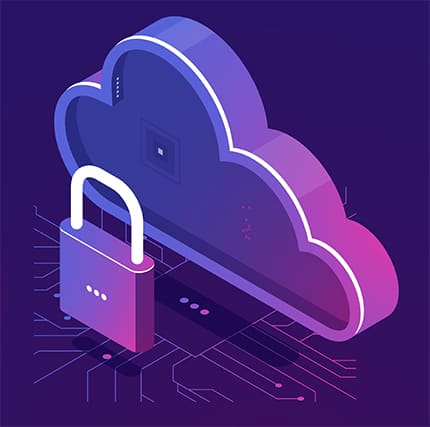Managed Detection and Response (MDR) in the AWS Cloud is a critical security control that organizations should consider when moving to the cloud. It offers continuous threat detection, response and deep forensic analysis capabilities for monitoring and responding to advanced threats. To protect their assets from malicious actors, it is essential for organizations to understand how MDR works in this context. This article will explore what Managed Detection and Response (MDR) is, its value proposition for cloud environments, and why organizations should embrace this technology.

The increasing number of cyberattacks targeting businesses has made cybersecurity an important concern for organizations of all sizes today. According to recent research data, more than 43 percent of companies have already experienced a successful attack on their systems within the past year alone, with the average cost per incident coming close to $2 million USD. In order to mitigate these risks, many enterprises have turned towards technologies such as Managed Detection and Response (MDR).
MDR provides comprehensive protection against both known and emerging threats by leveraging intelligent automation and analytics capabilities through machine learning algorithms. By continuously collecting data points from your environment across multiple channels including external sources such as blogs or forums, MDR can detect sophisticated attacks before they cause significant damage – resulting in reduced financial losses due to malicious activities. Additionally, it provides detailed reports outlining any suspicious activity detected during investigations so that corrective measures can be taken quickly and efficiently.
Table of Contents
What is Managed Detection and Response (MDR)?
Managed Detection and Response (MDR) is an approach to security that provides automated monitoring, detection, analysis and response capabilities. It enables organizations to detect malicious activity before it becomes a major threat or causes damage. MDR helps organizations of all sizes protect their assets, data, networks and systems from cyber threats.
In the AWS cloud environment particularly, MDR can provide real-time visibility into potential threats as they emerge. By leveraging the power of machine learning and artificial intelligence technologies, MDR solutions are able to quickly identify anomalous activities on AWS cloud platforms. This allows for rapid remediation of any issues found in order to reduce the risk of breaches or data loss due to malicious actors.
What Are The Benefits Of MDR In The Cloud
MDR in the cloud provides numerous advantages over traditional on-premise solutions. By using managed detection and response services, organizations can quickly detect threats and respond to them with minimal disruption to their operations. Additionally, MDR in the cloud enables organizations to benefit from quick scalability that allows for rapid expansion of resources as needed.
Organizations can use MDR in the cloud to reduce capital expenditures associated with building out or expanding an IT infrastructure. With a subscription-based service model, businesses pay only for what they need when they need it—saving time and money while also providing greater flexibility to meet changing business needs. Furthermore, implementing MDR in the cloud helps organizations maintain secure environments without needing dedicated personnel or additional hardware investments.
The benefits of MDR in the cloud extend beyond cost savings and convenience; by leveraging advanced analytics capabilities, businesses can gain valuable insights into emerging threats and trends within their environment more quickly than ever before. This leads to improved security posture through faster threat identification and containment, minimizing potential damage to critical data assets. As such, MDR services offer a comprehensive approach that is both cost-effective and efficient at protecting organizational assets against sophisticated cyber threats.
What Are The Security Controls With MDR?
Security controls are essential for the implementation of any Managed Detection and Response (MDR) solution in an AWS Cloud environment. Security controls provide a framework to identify, detect, prevent, and respond to cybersecurity incidents. They also ensure that data is stored securely within the cloud infrastructure as well as preventing unauthorized access from external sources.

AWS provides a comprehensive set of security capabilities available through its services, including Amazon Virtual Private Cloud (VPC), Identity and Access Management (IAM), Shield Advanced, Firewall Manager, GuardDuty, Macie and Inspector. These tools enable organizations to build secure environments with policies that meet their specific requirements while allowing them to monitor activity on their networks. Additionally, AWS offers features such as encryption at rest or in transit which help protect sensitive information and mitigate potential threats before they become reality.
This is important:
To guarantee maximum protection against malicious actors or misconfigurations leading to data loss or other security-related issues, it is important that organizations implement robust processes around these security controls and continuously monitor them over time so they can quickly react to any changes in their environment. Organizations should also leverage best practices when managing credentials used by users or applications accessing their systems.Data Collection And Analysis
Data collection and analysis is a critical component of managed detection and response (MDR) in the AWS Cloud. In order to detect malicious activity, organizations must collect data from various sources such as logs, OS events, network traffic and more. This collected data should then be analyzed for potential threats utilizing advanced anomaly detection algorithms. The aim of this process is to identify suspicious activities indicative of breaches or attack attempts that may have gone unnoticed by traditional security controls.
Organizations leveraging MDR services on AWS can take advantage of its extensive suite of cloud-native tools and services for collecting and analyzing data at scale. For example, Amazon GuardDuty provides automated threat detection capabilities using sophisticated machine learning models trained on large sets of known malicious behavior patterns. Additionally, Amazon Macie helps identify sensitive data stored within S3 buckets that might be vulnerable to exfiltration or misuse. Finally, Amazon Inspector enables users to continuously scan their applications for vulnerabilities which could lead to compromise if left unchecked.
These are just a few examples of the many tools available through AWS for effective data collection and analysis across an organization’s cloud environment – allowing it to quickly detect potential incidents before they cause harm.
Alerting And Investigation
The use of Managed Detection and Response (MDR) in the AWS cloud offers organizations a powerful suite of tools to detect, investigate and respond to potential threats. Alerting is an essential component of this process, allowing security personnel to quickly identify malicious activity or suspicious behavior. With MDR, alerts can be easily configured based on specific criteria such as IP addresses, user roles and other parameters.
The following are some of the features available:
- Log Analysis
- Aggregation – Correlates log data from multiple sources for deeper context
- Parsing – Breaks down complex logs into manageable chunks for easy analysis
- Search & Filter – Enables quick search by keyword/values within log data fields
Visualization Tools:
- Dashboards & Charts – Generate interactive visualizations with key performance indicators (KPIs).
- Timelines – Track network activities over time and gain insight into trends.
- Analytics – Utilize Machine Learning algorithms to uncover anomalies in large datasets.
These investigative tools provide valuable insights that help security teams rapidly triage incidents and take appropriate action accordingly. Furthermore, they offer detailed visibility into the environment while providing meaningful intelligence about possible attack vectors or malicious actors at work. By leveraging these mechanisms, organizations can better understand their risk posture and enhance security operations without having to invest additional resources in manual investigations.
Automated Remediation
Automated Remediation is an important component of Managed Detection and Response (MDR) in the AWS Cloud. This process allows for the automated execution of remedial actions when a security incident or threat is identified by MDR systems. The ability to implement automated responses to threats can significantly reduce response time and help ensure that organizations are able to quickly contain, investigate, and mitigate incidents more efficiently than ever before.

By leveraging automation for remediating incidents, organizations no longer need to manually respond; instead, they can specify rules within their cloud-based security tools that trigger automatic actions once a certain event occurs. Automation enables rapid response times as well as reduced costs associated with manual investigation and resolution processes. Additionally, this technology makes it easier for companies to track progress on resolving each incident so they can improve overall system performance over time.
Organizations should evaluate their current security posture and available resources in order to determine if automated remediation solutions would be beneficial. By understanding the benefits of implementing such technologies into existing security practices, businesses may experience improved overall IT infrastructure protection while simultaneously reducing operational costs due to fewer personnel hours required for manual investigation and resolution activities.
Security Operations Center (SOC)
Security Operations Center provides managed detection and response services in the AWS cloud. It is a centralized platform used to monitor, detect, investigate, respond and report on threats across an organization’s infrastructure. This includes both on-premises as well as cloud environments. The SOC provides 24/7 monitoring of potential security incidents and alerts that can be investigated quickly by security experts. In addition to this, they also provide threat intelligence tools that enable proactive identification and mitigation of malicious activities. These tools include network traffic analysis, log correlation and analytics, endpoint protection solutions and SIEM integration for advanced reporting capabilities.
The Security Operations Center allows organizations to reduce their overall risk exposure by providing visibility into suspicious activity happening within their environment. By leveraging automated technologies such as Machine Learning (ML) algorithms and Analytics Platforms, it enables faster incident investigation times compared to manual processes. Furthermore, its integrated service offerings allow customers to customize their solutions based on specific requirements such as compliance or industry regulations like HIPAA or GDPR.

Finally, with its real-time alerting capability combined with intelligence-driven investigations, Security Operation Centers ensure maximum uptime even in highly dynamic IT environments while reducing operational costs associated with responding to incidents manually. Organizations are able to receive detailed reports about identified events that help them take corrective measures before serious damage occurs due to malicious activities.
Third-Party MDR Solutions
The next step for organizations looking to maximize their security posture is managed detection and response (MDR) in the AWS cloud. MDR solutions offer additional capabilities beyond a Security Operations Center (SOC), providing monitoring, alerting, investigation, and automated remediation of threats. With an MDR service, an organization can gain visibility into all activity on their network, including user behavior analytics and threat intelligence feeds from multiple sources. Additionally, they will have access to experienced engineers who are trained in identifying malicious activities faster than SOCs.
Third-party MDR solutions provide organizations with a comprehensive approach to identify potential threats before they become attacks. These solutions use sophisticated machine learning algorithms to detect suspicious activity in real-time and generate alerts that enable teams to take action quickly. Furthermore, these services also help reduce false positives by leveraging data science techniques such as anomaly detection which identify patterns or trends in datasets that could indicate malicious intent. This allows teams to narrow down investigations based on the most credible threat indicators.
Organizations should consider third-party managed detection and response solutions when looking for a more robust security solution for protecting their AWS workloads. The automation provided by these services helps streamline processes so IT staff can focus on other tasks while still being able to respond quickly if any incident occurs. Additionally, it provides better protection against advanced threats through its ability to detect malicious activity earlier and react more rapidly than traditional approaches used by SOCs alone do not allow for this level of granularity or speed of reaction.
Compliance Requirements For AWS MDR Services
The AWS cloud is a secure and compliant platform for the deployment of Managed Detection and Response (MDR) services. To ensure compliance with applicable laws, rules, regulations, guidelines, and industry standards, MDR service providers must meet certain requirements when deploying their services in the AWS cloud.
Below are four key considerations that must be taken into account:
- Data security requirements: All customer data related to MDR services must comply with local privacy laws such as GDPR or CCPA. Additionally, all personal data collected by MDR services should be encrypted at rest and in transit using approved encryption protocols.
- Access control policies: Appropriate access control measures must be implemented throughout the entire system architecture to protect against unauthorized access to sensitive information including credentials and audit logs. This includes procedures for authenticating users and granting permissions based on user roles within organizations.
- Monitoring & alerting capabilities: It is essential to have real-time monitoring capabilities for detecting suspicious activity across all systems used by an organization’s MDR service provider so that incidents can be identified quickly and responded to promptly before they cause any damage or disruption of business operations.
- Regulatory compliance standards: Service providers must also demonstrate compliance with relevant regulatory frameworks such as FedRAMP or ISO 27001/27002 when offering their services in the AWS cloud environment.
Adherence to these requirements helps ensure that customers’ data remains protected while enabling them to deploy reliable MDR solutions that meet their specific needs without compromising on security or performance levels. By proactively addressing potential risks associated with MDR deployments through rigorous testing processes, service providers can help customers realize maximum value from their investments in this technology solution over time.
Cost Considerations For MDR On AWS
First and foremost is the cost of the software license as well as any associated maintenance costs. This can vary greatly depending on the vendor chosen and whether there are additional modules or components that need to be purchased. Additionally, organizations must consider staffing resources to properly configure and manage the chosen solution. Depending on the complexity of their environment, some organizations may require more personnel than others. Finally, it is important to remember that both ongoing operational costs such as storage fees and compute costs will also need to be factored into the budget planning process.

These various cost considerations must all be taken into account and you will need to be right on top of your AWS cost management before making a decision about investing in an MDR system on AWS. Organizations should take time to review these elements carefully prior to committing financial resources to ensure they have made an informed decision regarding their security posture within cloud environments.
Amazon GuardDuty Overview
Amazon GuardDuty is an AWS cloud-based managed detection and response (MDR) service. It provides intelligence to detect malicious activities in the AWS environment, helping organizations to identify potential threats quickly and protect their applications from unauthorized access or data exfiltration attempts. This MDR solution leverages machine learning algorithms to analyze large amounts of incoming logs and activity data across multiple AWS services. Amazon GuardDuty also uses threat intelligence from external sources such as VirusTotal and third-party intelligence feeds to provide additional context on suspicious events. The system can alert users when it detects potentially risky behavior, allowing them to take corrective measures before any damage occurs.
In addition to providing alerts, Amazon GuardDuty also offers recommendations for remediating identified security issues with specific steps that are tailored to each customer’s unique environment. Furthermore, customers can customize which types of threats they would like the system to prioritize so that they receive only relevant notifications about security incidents that affect their organization’s resources. Finally, Amazon GuardDuty utilizes various methods such as email notifications, dashboards, and SNS topics to communicate security findings and enable quick responses by the operations team.
Amazon Macie Overview
Amazon Macie is a security service that helps organizations protect their data stored in the AWS Cloud. It uses machine learning and pattern recognition to identify, classify, and protect sensitive data such as personally identifiable information (PII) or intellectual property. Amazon Macie also provides visibility into access control lists (ACLs), resource policies, IAM roles, and other security configurations across all of an organization’s AWS resources. This makes it easier for businesses to maintain compliance with industry-specific standards like PCI DSS or HIPAA.
The service can detect anomalous activities associated with user accounts, such as excessive API calls or attempts to modify confidential data. It also sends alerts when unusual network activity takes place on the cloud environment, helping organizations stay aware of potential threats before they become serious issues. Additionally, Amazon Macie enables customers to generate detailed reports about their current security posture which are useful for making informed decisions regarding system hardening and response planning.
Note:
By leveraging Amazon Macie’s capabilities within Managed Detection and Response services in the AWS Cloud, organizations can gain valuable insights into their environments while simultaneously reducing risks associated with unauthorized access or malicious actors attempting to steal confidential information from the cloud infrastructure.How To Configure MDR On AWS
Configuring Managed Detection and Response (MDR) on the Amazon Web Services (AWS) cloud requires a few steps.
These include:
- Creating an AWS account
- Subscribing to MDR services offered by third-party providers such as Alert Logic, IBM Resilient or Trend Micro Deep Security
- Connecting the service provider’s console with your existing infrastructure within AWS.
To create an AWS account, simply sign up through their website using basic information like name, email address and payment option of choice. After signing up for an account, users must subscribe to one of several available MDR solutions from providers that offer it in the form of software packages specifically designed for AWS environments. Once subscribed, customers can begin configuring their environment according to the specific instructions provided by each vendor; however, some common tasks may be required regardless of which vendor is chosen such as establishing credentials within AWS in order to connect the MDR platform with other resources within its ecosystem.
For example:
- Establish IAM roles so access policies can be defined for particular services
- Create CloudWatch event rules based on user-defined criteria
- Set up VPC flow logs capture log data related to network traffic
Once all prerequisites are met, customers will have successfully connected their MDR solution with their existing infrastructure within AWS and have set themselves up for success when responding quickly and effectively to security incidents while remaining compliant with industry standards and regulations if applicable. To ensure optimal performance of any MDR solution deployed on the AWS cloud, regular maintenance should also be conducted at least once every quarter in order to detect changes in system configurations or misconfigurations that could potentially lead to unplanned downtime or worse yet – a security incident.
Best Practices For Securing The Cloud Environment
Managed Detection and Response (MDR) in the AWS Cloud requires best practices to be implemented in order to ensure optimal security of cloud-based environments. Firstly, organizations should define the risk profile they wish to maintain by implementing comprehensive identity and access management policies that require a multi-factor authentication approach when granting users access. Additionally, organizations should consider leveraging centralized logging solutions such as Amazon CloudWatch Logs or third-party software components to securely store and analyze log data for malicious activity. Furthermore, system hardening techniques are necessary steps towards reducing attack surface area on systems within an environment; this includes patching operating systems with up-to-date versions, configuring firewalls appropriately, disabling unused services and settings, etc.
Organizations should also deploy intrusion detection/prevention capabilities along with advanced analytics tools like Amazon GuardDuty or Macie which provide visibility into potential threats before any damage is done. Automating security measures via scripting languages can further reduce manual efforts associated with processes such as account provisioning, patching, system updates, etc., allowing administrators more time to focus on other tasks.
Lastly, it is essential for organizations to implement threat intelligence feeds from reliable sources in order to gain insight on ongoing cyber threats in the wild so appropriate countermeasures can be put in place. By utilizing these best practices combined with MDR solutions available through AWS offerings such as AWS Security Hub and AWS WAF & Shield Advanced customers can secure their cloud infrastructure while maintaining compliance standards applicable within their industry sector.
Challenges Of Implementing MDR On AWS
The implementation of Managed Detection and Response (MDR) on AWS presents a range of challenges. These include:
- Limited visibility: The lack of visibility into the cloud environment leaves users vulnerable to threats that can easily go undetected, as well as the difficulty in detecting malicious activity within the environment. This is due to a number of factors including shared responsibility models, limited logging capabilities, and differences between public cloud infrastructure and traditional data centers.
- High costs: MDR solutions are often expensive with many organizations having difficulty affording them, especially when they require additional hardware or software components such as an agent installed on each server. Furthermore, these costs may not be fully justified if there is no clear understanding of how the solution will help protect against potential threats.
- Complexity: Deploying MDR services on AWS requires extensive planning and configuration which could lead to lengthy deployment times and higher operational overhead. Additionally, managing multiple security vendors across different regions can be complicated due to their separate management consoles, policies, and configurations.
- Setting up: This includes configuring access control lists (ACLs), network segmentation rules, VPC peering connections, identity access management (IAM) roles/policies for MDR service accounts etc., all tailored according to specific business requirements.
- Maintenance & Monitoring: Ensures that alerts generated by MDR services are regularly monitored and investigated promptly; also involves keeping track of changes in policy settings for maximum efficiency.
Due to the complexities associated with implementing MDR on AWS, it is essential for businesses to have sufficient resources devoted towards achieving this goal – whether through internal staffing or third-party assistance – while taking into account cost-effectiveness considerations as well. With thorough preparation prior to deploying MDR on AWS Cloud platform however, companies should be able to reap its benefits over time despite any initial difficulties encountered along the way.
Overall, using MDR in a cloud environment has many advantages; however there are some challenges associated with its implementation including cost considerations and organizational structure alignment issues. Careful consideration should be taken prior to embarking upon an effort to implement MDR on AWS but when done correctly it can significantly reduce risk while providing added levels of protection against cyberattacks.

